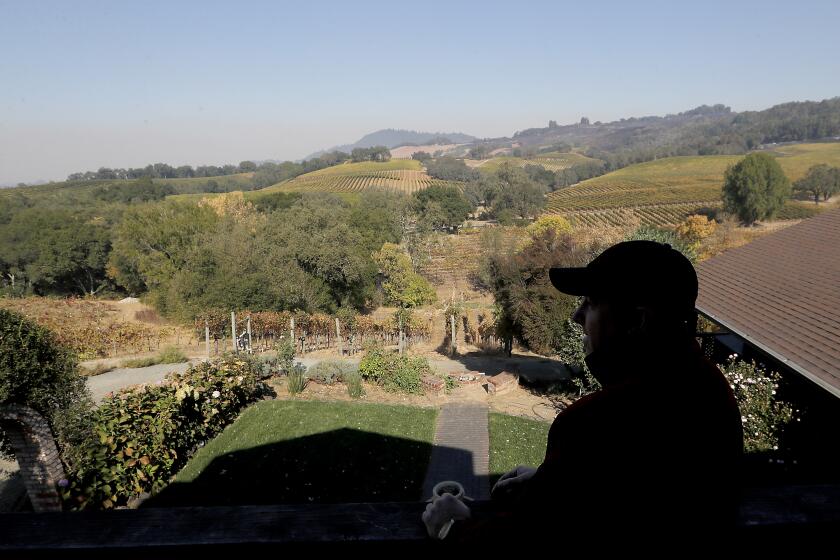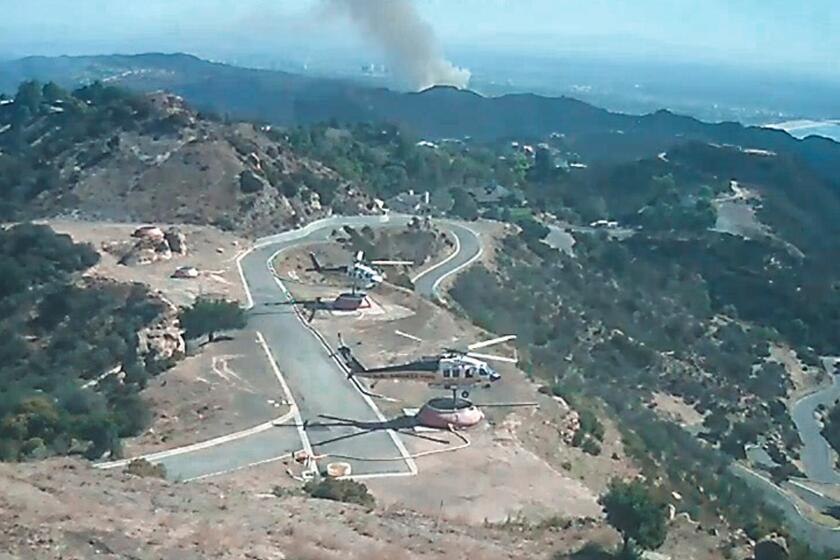Fire sparked as Edison turned power back on points to another hazard for utilities

- Share via
California utilities were already in a bind, between intense criticism when they shut off power and financial peril when they don’t during high fire hazard episodes.
Now an announcement by Southern California Edison has introduced a third dimension to the dilemma: the risk of turning that power back on too soon.
In an incident report filed with the Public Utilities Commission on Friday, Edison said it had shut down a 16,000-volt power line near Santa Paula last week following its fire-safety protocol but then re-energized the line approximately 13 minutes before the estimated ignition of the Maria fire.
In a statement, Edison spokesman Ron Gales said Saturday that “while we have no information about the cause of the fire,” the line on South Mountain was “near the area of the reported location of the fire.”
The announcement adds to the troubles the utility faces over the role its equipment may have played in several recent Southern California fires.
The things that set California apart, for better or worse, were all there last Sunday afternoon: terrifying flames, wine country glamour and a rescue straight out of Hollywood.
Also last week, Edison disclosed that its electrical equipment will probably be found to be “associated” with the 2018 Woolsey fire, which burned almost 97,000 acres, destroyed more than 1,500 structures in Los Angeles and Ventura counties and killed three people.
Though a final investigation by authorities has not been completed, Edison reported it “observed a pole support wire in proximity to an electrical wire that was energized prior to the outage” and concluded “its equipment could be found to have been associated with the ignition of the Woolsey fire.”
It was already facing the possibility of major liability for the Thomas fire in 2017, which burned more than 280,000 acres in Santa Barbara and Ventura counties and was followed by deadly mudslides in Montecito.
Then last month Edison faced new criticism over the Saddleridge fire, which scorched 8,000 acres and destroyed 17 structures in Sylmar, after it disclosed to regulators that its equipment in the area was “impacted” about the time the fire began, but hasn’t offered further details.
In its quarterly earnings report, the utility giant said the various fire and mudslide events could result in a liability of $4.7 billion, of which $1.8 billion will be borne by shareholders after insurance and other offsets. But in the company’s third-quarter earnings call last week, Edison International President and Chief Executive Pedro J. Pizarro said it was adequately prepared for the blow.
A wealthy former executive and L.A. County have transformed this picturesque property in the Santa Monica Mountains into a remote base for helicopters to refill their water tanks — a spot that’s helping prevent small fires from turning catastrophic.
Edison “understands this is a difficult time for the many people who are being impacted,” according to a statement from the company Saturday. “The company’s top priority is the safety of customers, employees and communities, which is why we continue to enhance our wildfire mitigation efforts through grid hardening, situational awareness and enhanced operational practices.”
The protocols for shutting down power are outlined in Edison’s 2019 Wildfire Management Plan. Incident management teams that include Edison meteorologists base the decision on wind speeds, humidity and temperature, fuel moisture and fuel loading.
But other less prescriptive considerations may include potential effect on customers and communities, alternative ways to reroute power, the progress of the customer notification process and “situational awareness” from weather stations, the plan says.
The length of time customers are without power is one factor that may be considered in the decision to restore power.
“The order in which circuits are re-energized will depend on many factors including, but not limited to, customer safety and well-being, consideration of affected essential services, damage to electrical and other infrastructure, and circuit design/topology,” the report states.
Before power is restored field crews inspect the lines for “any condition that could potentially present a public safety hazard when re-energizing circuits.”
Damaged equipment must be repaired.
The duration of a power outage can matter in small and large ways. Disaster preparedness advisers suggest that food may last only four hours in a closed refrigerator, while frozen food could last a day or two, depending on how full the freezer is, as long as the door stays shut most of the time.
For those dependent on medical equipment requiring rechargeable batteries, time can be critical.
Edison’s plan says it maintains a list of those customers and contacts them individually before a shutdown. If unable to confirm the notification, field representatives go to the customer’s house.
More to Read
Sign up for Essential California
The most important California stories and recommendations in your inbox every morning.
You may occasionally receive promotional content from the Los Angeles Times.
















